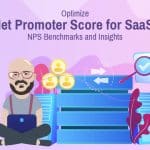Playback speed:
The world of software as a service (SaaS) presents unique challenges when it comes to tracking the effectiveness of your marketing strategies. A multitude of SaaS marketing metrics, such as customer acquisition cost (CAC), monthly recurring revenue (MRR), and net promoter score (NPS), among others, need constant monitoring.
However, not all metrics carry equal weight. Prioritizing specific metrics over others based on business needs and goals is crucial to driving growth and maintaining profitability in the dynamic landscape of SaaS marketing. This understanding forms the basis for an effective service-selling strategy.
Our guide to SaaS marketing metrics introduces you to the most important ones, their meaning, and how to keep them optimal.
Keep on reading to find out more.
SaaS Marketing Metrics [Key Takeaways]
- Software as a Service (SaaS) marketing metrics are crucial indicators of growth and profitability.
- Tracking and reducing the churn rate is essential for sustainable SaaS growth.
- Calculating both customer acquisition cost (CAC) and customer lifetime value (CLV) aids in gauging your business’s profitability.
- Maintain strong customer relationships to boost your recurring revenue, whether it be monthly recurring revenue (MRR) or annual recurring revenue (ARR).
- The net promoter score (NPS) measures customer satisfaction, driving your service-selling strategy.
- Monitoring the lead velocity rate (LVR) can guide future growth, helping to maintain positive conversion rates in your SaaS marketing efforts.
SaaS Marketing Metrics Tracking: Why Is It Important?
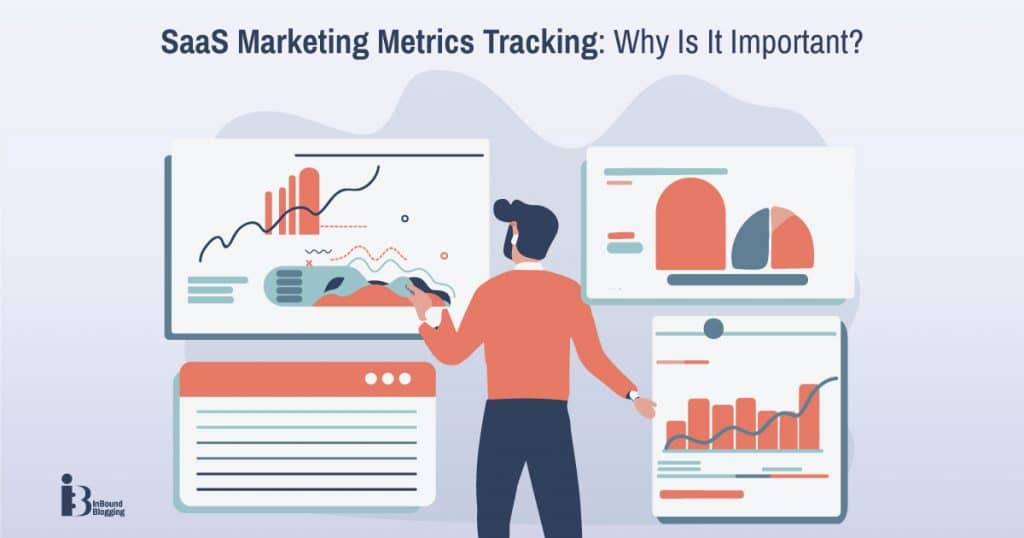
The fundamental idea of SaaS rests on selling a service, not a physical product. This distinction necessitates a shift in marketing strategy, which inherently requires bespoke metrics to assess its effectiveness.
In contrast to conventional B2B product marketing, where a transaction might represent the end of the customer journey, in SaaS marketing, a transaction is just the beginning. Customers are charged fees on a recurring basis, often monthly or annually, making their lifetime value (CLV) much more significant than their initial registration. The long-term nature of these relationships makes factors like churn rate and net promoter score (NPS) paramount.
Tracking standard metrics can be misleading for SaaS businesses. Let’s look at these examples to find out why:
- High-volume registrations would imply success in conventional B2B settings. However, without focusing on customer retention and ensuring low churn rates in the SaaS business model, this achievement becomes hollow.
- A high SaaS gross margin may give the illusion of profitability. But ignoring figures like monthly and annual recurring revenue and taking customer acquisition cost (CAC) into account can result in unexpected losses.
Metrics play an instrumental role in guiding strategy decisions by providing tangible data to analyze. Recorded trends can uncover areas that need attention. For example:
- An increasing churn rate could indicate dissatisfaction with the service.
- A low LVR might put long-term growth at risk.
- NPS ratings can measure customer satisfaction and loyalty.
- Comparative analysis of CAC and CLV helps evaluate business profitability.
Tracking these SaaS marketing metrics provides insights to refine and optimize business strategies, resulting in higher customer satisfaction, retention, and ultimately profitability.
Essential SaaS Marketing Metrics You Need to Track
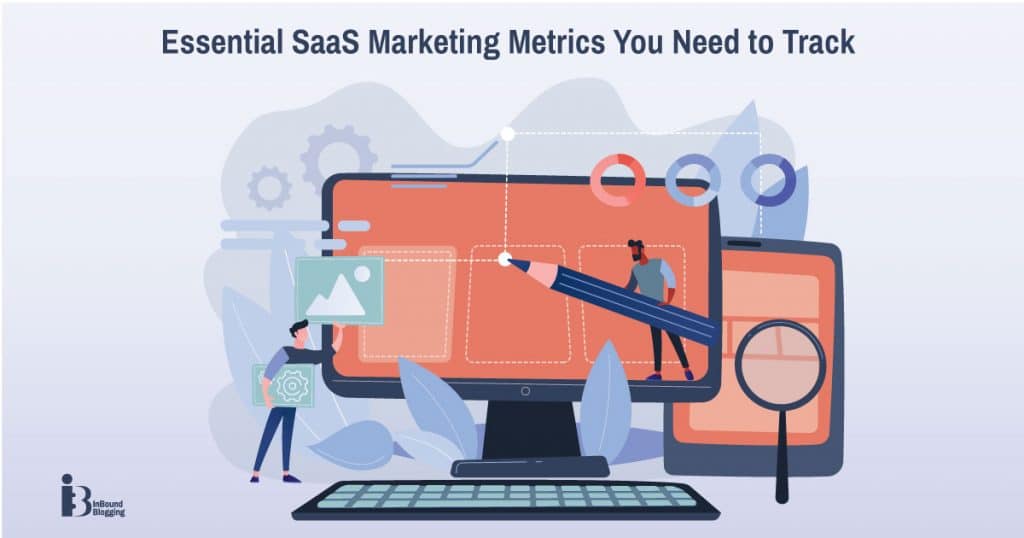
In the world of SaaS, efficient marketing metrics are paramount to evaluating the effectiveness of your growth strategies.
Let’s walk you through the seven top B2C and B2B SaaS marketing metrics that will unlock your company’s potential.
- Churn: a crucial metric for SaaS success
The churn rate is one of the key SaaS marketing metrics. It reflects the percentage of customers who discontinue their subscription over a specific period. Therefore, it’s inversely related to customer retention.
To calculate churn, divide the number of customers lost during a given time frame by the total number of remaining customers:
Churn rate formula:
Churn rate = [(Number of Customers at Beginning – Number of Customers at End) / Number of Customers at Beginning] x 100
Illustrative table:
| Period | Starting Customers | Ending Customers | Churn rate |
| Quarter 1 | 150 | 135 | 10% |
Churn rate = [(150 – 135)/150]*100 = (15/150)*100 = (1/10)*100 = 10%
Minimizing churn not only signifies satisfied customers but also contributes to sustainable growth. Churn-reducing strategies such as proactive customer service and loyalty programs can help keep customers engaged and loyal to a company. Additionally, providing customers with value-based incentives can help to encourage them to stay with a company long-term.
“If the churn rate is high, I would investigate the reasons behind customer cancellations, which could be related to product usability, pricing, or customer support. If conversion rates are low, I might analyze user behavior on the RecurPost website and experiment with different landing pages to identify where potential customers drop off.” — Debbie Moran, Marketing Manager, RecurPost
Monthly recurring revenue (MRR) and annual recurring revenue (ARR)
MRR and ARR are key SaaS sales and marketing metrics for assessing long-term customer relationships. MRR represents the predictable revenue that a company can expect every month, while ARR signifies yearly recurring revenue from subscriptions.
An effective client onboarding process boosts conversion rates, thereby enhancing MRR and ARR. Similarly, providing an exceptional customer experience fosters strong customer relationships, resulting in high revenue retention.
The computation can be done via these formulas:
MRR = Total Number of Paying Users x Average Revenue Per User
ARR = MRR x 12
These figures provide you with valuable insight into your cash flow situation as well as your sales performance. ARR is a more accurate indicator of your business’s performance than MRR. ARR is used to measure growth and stability over a longer period of time. MRR is useful for understanding short-term trends.
So, how to keep your clients around for longer? Except for regular improvement of your SaaS product or service, you need to think of ways to nurture your clientele. One way to do that is via a targeted email marketing campaign or offering exclusive offers and updates.
Customer acquisition cost (CAC) and customer lifetime value (CLV)
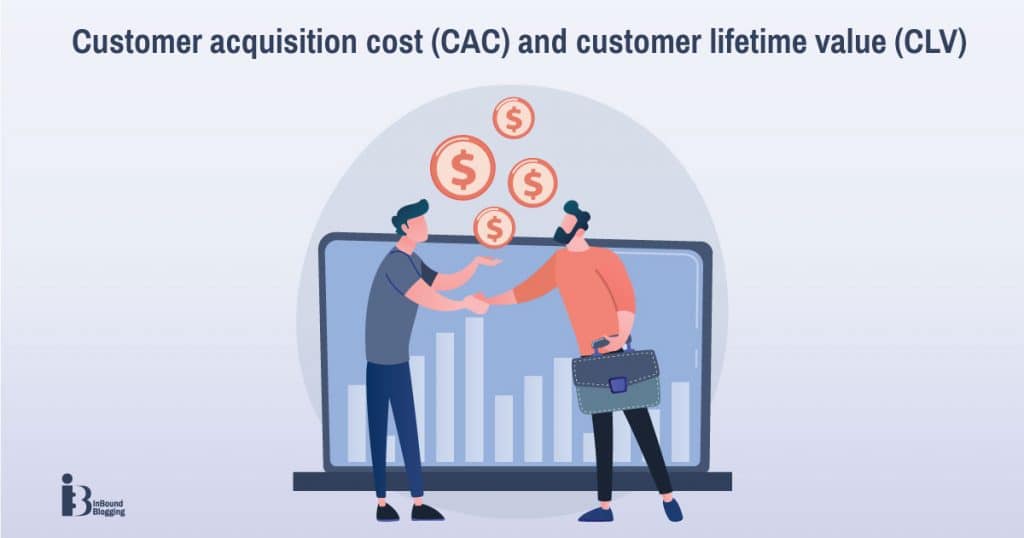
CAC gauges the average expense of acquiring a customer, an important SaaS metric to plan investments in advertising. CLV, on the other hand, gives insight into the total revenue one can anticipate from a customer over their lifetime.
Maintaining a balanced ratio between CAC and CLV indicates sound business health.
CAC = Total Acquisition Cost / Total New Customers Acquired
CLV = (Average Profit per Customer x Average Lifespan of a Customer) – CAC
A CAC:CLV ratio of 1:3 is considered perfect, according to SaaS marketing metrics benchmarks. If it is bigger than this, it indicates that the business is spending too much money on acquisition and not enough on customer retention.
A CAC:CLV ratio of less than 1:3 indicates that the business is not doing enough to acquire new customers and will need to increase acquisition efforts.
If that’s the case with your company’s CAC:CLV ratio, it might be time to rethink your SaaS marketing strategy. Use different marketing channels to reach your prospects, focus on social media marketing, implement marketing automation, etc.
“If your CAC is too high and your conversions from meeting-to-opportunity or close/win rates are low, then you need to investigate and determine where to optimize. It’s important to trace your strategy from the beginning to the end (and from the end to the beginning!) to identify areas of weakness and strength and focus on replicating the wins and fixing the weaknesses.” — Amber Bogie, Senior Director of Global Demand Generation, Reachdesk
Net promoter score (NPS): measuring customer satisfaction
NPS serves as a reliable barometer of customer satisfaction and product value. It uses a scale from 100 to 100) to sort customers into promoters, passives, and detractors, thereby giving you an understanding of your brand’s reputation.
NPS = % Promoters – % Detractors
A high SaaS NPS indicates most customers are promoters who may bolster growth through word-of-mouth referrals. SaaS companies should focus on increasing the percentage of promoters by improving customer satisfaction and engagement, as well as reducing the percentage of detractors through better customer service and support.
Lead velocity rate (LVR): an indicator of long-term growth
LVR measures your company’s month-by-month growth in sales qualified leads, indicating future revenue potential.
Sales qualified leads (SQLs) and marketing qualified leads (MQLs) are two types of qualified leads that correspond to different stages of the marketing funnel.
MQLs are leads that have shown interest in a product or service but are not ready to buy yet. They may have downloaded a white paper, signed up for a webinar, or filled out a contact form.
SQLs have expressed a clear intent to purchase, and have met the criteria set by the sales team. They may have requested a demo, asked for a quote, or agreed to a trial. SQLs are more likely to become customers than MQLs and require more attention from the sales team.
LVR = [(Number of Qualified Leads this Month – Number of Qualified Leads Last Month) / Number of Qualified Leads Last Month] x 100
High LVR signifies effective marketing campaigns generating increased sales-ready leads, which will ultimately translate into higher revenue. A low LVR can indicate that a company is not effectively targeting the right audience or that its marketing campaigns are not effective. SaaS companies should monitor LVR regularly to ensure they are on track to reach their goals.
SaaS buyers are generally eager to learn, so developing a strong content marketing strategy is a reasonable move. An informative and reliable blog could contribute to turning your qualified leads into paying customers.
Vanity SaaS Marketing Metrics vs. Actionable SaaS Marketing Metrics
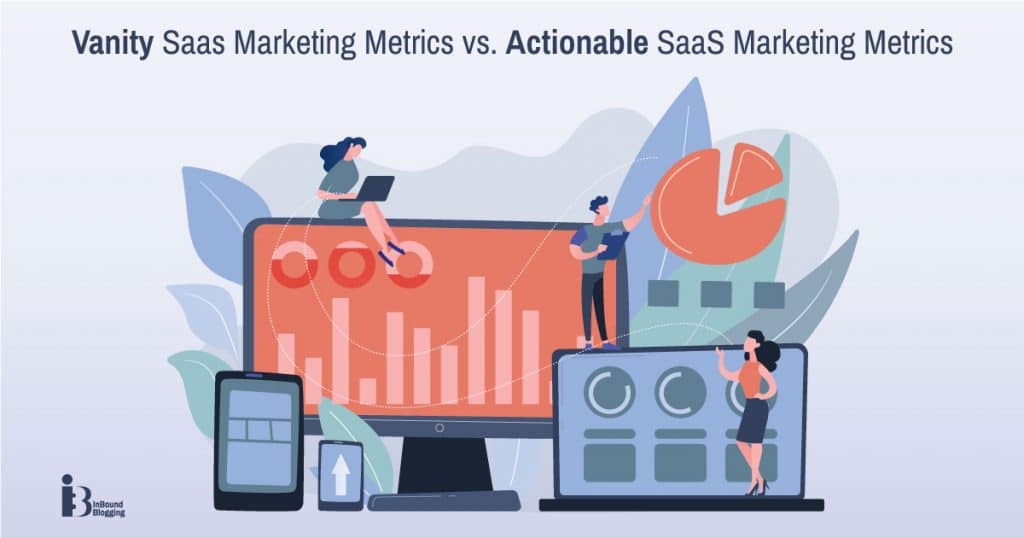
Understanding the difference between vanity metrics and actionable SaaS marketing metrics is mandatory for all SaaS marketers. That could be the factor that guides your SaaS business from a meandering, uncertainty-filled journey to a strategic and focused road to success.
Let’s see what differentiates these two types of metrics and why it’s crucial for any SaaS company to prioritize actionable over vanity metrics.
Vanity Metrics
These are data points that may inflate the perceived success of your product or service but do not necessarily have any substantial impact on profit margins or customer relationships. They include figures like the total number of downloads, email subscribers, registered users, and social likes/follows—the “feel-good” data points. However entertaining they might be, they don’t offer significant insights that can improve customer experiences or guide growth strategies.
“Common mistakes businesses make when tracking SaaS marketing metrics include focusing on vanity metrics that don’t directly impact business growth, not aligning metrics with business goals, and failing to track metrics consistently over time. To avoid these mistakes, businesses should clearly define their goals, select metrics that align with those goals, establish a consistent tracking process, and regularly review and analyze the data to inform decision-making and optimize marketing strategies.” — Vaibhav Kakkar, CEO, Digital Web Solutions
Actionable metrics
Contrastingly, tracking actionable metrics provides you with valuable insights about your business profitability—your churn rate, monthly recurring revenue (MRR), annual recurring revenue (ARR), customer acquisition cost (CAC), customer lifetime value (CLV), etc.
These critical SaaS marketing metrics give an accurate reflection of your business trajectory. This, in turn, aids you in making informed decisions and helps your SaaS marketing team develop more efficient marketing plans.
Let’s visualize these differences:
| Vanity Metrics | Actionable Metrics |
| Number of likes | Churn rate |
| Page views | Monthly recurring revenue (MRR) / Annual recurring revenue (ARR) |
| Total downloads | Customer acquisition cost (CAC) |
| Registered users | Customer lifetime value (CLV) |
“CLV helps us predict customer income during their service engagement. We can adapt our marketing campaigns and retain high-value clients using this data. We can invest in client satisfaction, personalization, and upselling/cross-selling.
Additionally, it helps us deploy our marketing budget more efficiently, increasing ROI. In a fast-paced, ever-changing business like IT, marketing optimization is essential. Sustainable business growth requires recruiting new clients and managing existing relationships, which CLV provides. It helps us make data-driven decisions to service clients, maintain trust, and stay ahead in the digital world.” —Vikas Kaushik, CEO, TechAhead
SaaS Marketing Metrics Summary
In the dynamic world of SaaS tracking and acting upon metrics is essential for sustainable growth and profitability. We’ve explored several important metrics, each signifying crucial aspects of your company’s performance.
Churn rate, inversely related to customer retention, measures the percentage of subscribers who discontinue their subscription within a certain period.
MRR (monthly recurring revenue) and ARR (annual recurring revenue) are significant indicators that quantify the expected revenue from subscriptions over a year or month, respectively. The quality of your onboarding process directly affects these metrics.
CAC (customer acquisition cost) and CLV (customer lifetime value) offer valuable insight into your profitability. CAC signifies how much your business spends to acquire a new customer, while CLV reveals the total revenue expected from each subscriber throughout their relationship with you.
The net promoter score (NPS) provides an assessment of customer satisfaction and loyalty—a high score confirms that you provide value to users in terms of features, service, and overall experience.
The final key metric we touched on was the lead velocity rate (LVR), which denotes future revenue potential based on month-by-month growth in qualified leads—it’s a clear signal telling whether your marketing efforts are successful or need tweaks.
Here’s a summarized table:
| Metric | Description | Significance |
| Churn rate | Measures lost customers over time | Vital determinant for retention strategies |
| MRR / ARR | Predicts recurring revenue from subscriptions | Indicates financial health and growth |
| CAC / CLV | Stands for acquisition cost vs. lifetime value per customer | Key indicators of business profitability |
| NPS | Reveals customer satisfaction/loyalty stats | Guides product improvement and branding |
| LVR | Shows growth in qualified leads month over month | Helps test the effectiveness of marketing strategies |
Every single one of these metrics can guide your future strategies and allow you to tailor them specifically for what your SaaS needs. Remember, it’s not just about knowing these numbers; it’s what you do with what they tell you that really counts.
“Ultimately, you need to ensure that your CRM, web analytics, and revenue attribution tools are properly configured and that you’re tracking the prospect touchpoints at every stage of the funnel. Scale the channels and campaigns that have the biggest impact on bottom-of-the-funnel metrics, and deprioritize or cut the ones that don’t.” — Linas Zemaitis, VP Marketing, Whatagraph
In the evolving world of SaaS marketing, adaptation to current industry standards while catering to customers’ needs is paramount—keep track, keep adapting.
Conclusion
Understanding and applying top SaaS marketing metrics is integral to the success and growth of any SaaS business. These metrics allow you to identify strengths, expose areas for improvement, and facilitate informed decision-making.
Through a comprehensive grasp of these important indicators, businesses can optimize customer experiences, improve product offerings, increase engagement, and ultimately drive growth. As the SaaS landscape continues to evolve, monitoring your success numerically will paint you a clear picture of where you’re headed.
FAQ
What are SaaS marketing metrics?
SaaS marketing metrics are crucial performance indicators, known as marketing KPIs, pivotal for measuring the growth and effectiveness of a SaaS operation.
They encompass factors like:
– Customer acquisition cost (CAC): the total cost incurred to gain a new customer.
– Customer lifetime value (CLV): an estimate of the total revenue expected from each customer across their tenure with your business.
– Churn rate: outlines customer retention by calculating how many customers end their subscription in a defined period.
Other important ones include monthly recurring revenue (MRR), annual recurring revenue (ARR), and net promoter score (NPS), all of which contribute to progressive growth strategies in SaaS businesses.
What does SaaS metrics tracking imply, and why is it a critical process?
The practice of monitoring SaaS metrics corresponds to keeping a close eye on the vital performance measures that can demonstrate the level of success garnished by a SaaS enterprise. The importance of this cannot be overstated, as gathering data points around the following areas can inform essential strategic assessments and decision-making processes:
– Customer acquisition
– Levels of customer turnover or churn rate
– Patterns in revenue growth
– Fluctuations in customer satisfaction
How do B2B product and SaaS marketing analyses differ?
Whereas conventional business-to-business product marketing typically revolves around once-off sales with a strong focus on physical products meant for end-user consumption, SaaS marketing takes an entirely different approach. This methodology places emphasis predominantly on selling digital services via recurring subscriptions, thus fostering ongoing relationships with customers rather than one-and-done transactions.
Moreover, due to its subscription-based model hingeing upon repeat business from satisfied clientele over an extended period, there’s an even stronger imperative for meticulous focus on sustaining and enhancing customer value within these ongoing relationships, contributing to steady revenue streams.
Why is churn rate an important metric for SaaS companies?
Churn rate serves as a cardinal metric that any SaaS enterprise should hold dear—it calculates the percentage or ratio of clients who opt to cancel their ongoing subscription service over a given time span. A churn rate leaning toward the higher side may denote underlying dissatisfaction amidst your client base or possibly systemic service-related issues your company needs to address promptly.
Keeping track of churn rate sciences out your business’s potential areas needing enhancement, thereby enabling the crafting of more effective strategies aimed at augmenting overall customer retention.
What’s the difference between monthly recurring revenue (MRR) and annual recurring revenue (ARR)?
MRR and ARR function as quintessential SaaS revenue metrics. Monthly recurring revenue encapsulates the projected revenue that your firm derives from ongoing subscriptions for every given month. Conversely, annual recurring revenue projects the likely income that your company stands to earn from its subscriptions on a year-on-year basis.
A comprehensive grasp of these figures unlocks useful insights into fiscal stability, with the added advantage of assisting in predicting future financial scenarios.
What’s the connection between CAC and CLV?
CAC exemplifies your organization’s expenditure while attempting to reel in new clients within a designated timeframe. This calculation includes all expenses accrued due to marketing campaigns, branding exercises, and similar attempts at attracting more business.
On the contrary, CLV gauges the total amount of revenue your company forecasts it will receive from a client throughout its tenure as an active customer.
While CAC helps evaluate whether your marketing initiatives are delivering a worthy bang for each buck being spent, CLV provides deeper insights surrounding every customer’s potential value to your enterprise. A thoughtful juxtaposition of both these metrics can shine light on whether you’re potentially overspending resources toward gaining fresh customers relative to their foreseeable long-term value.
How does net promoter score (NPS) gauge customer satisfaction levels?
Net promoter score serves as an industry-standard methodology employed widely across sectors for measuring levels of satisfaction and loyalty among customers. An NPS score is manifested based on responses provided by customers regarding their likelihood of advocating for your services amongst others.
This stratifies them into three distinct groups: promoters (enthusiastic advocates), passives (neutral consumers), and detractors (potentially damaging critics). NPS scores leaning toward the higher side can denote positive customer satisfaction levels, bringing enduring value to your SaaS organization by enhancing its standing in the market.
What does lead velocity rate (LVR) indicate?
LVR, or lead velocity rate, quantifies the pace at which the pool of potential qualified leads at your company’s disposal grows over subsequent months—a sure-shot signifier for future sales potential and an indicator for estimating long-term growth prospects. An ascendant LVR communicates that your lead-generation efforts are bearing fruit, leading to increasing pools of prospective clients and thereby signaling promising scope for continued growth within your SaaS business.
How to optimally utilize SaaS marketing metrics?
Though numbers and data analysis do play a fundamental role, they tell only half the story—how you interpret and apply these analytics shapes the true effectiveness of these metrics. The goal is not merely data collection but rather leveraging those insights to drive informed decision-making.
Utilize SaaS metrics as a guided compass illuminating both areas of operational excellence and spots necessitating improvement. Streamline efficiency where needed, adapt strategic plans based on quantitative assessments, fine-tune service offerings vis-à-vis client feedback, or make bold alterations when necessary. All this ensures competitive edge remains intact even amidst dynamically shifting market scenarios.
